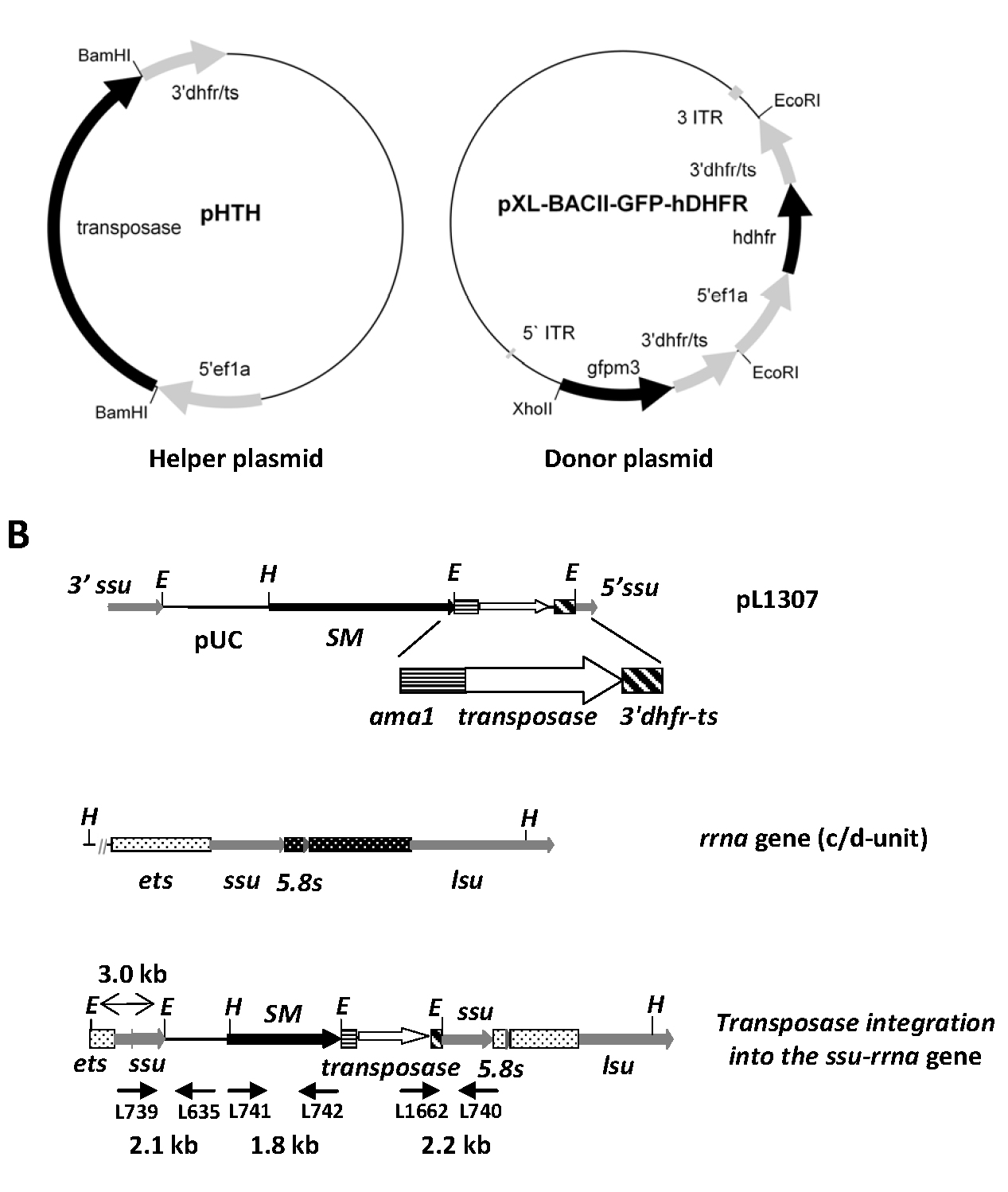SummaryRMgm-406
|
||||||||
 *RMgm-406
*RMgm-406| Successful modification | The parasite was generated by the genetic modification |
| The mutant contains the following genetic modification(s) | Introduction of a transgene |
| Reference (PubMed-PMID number) |
Reference 1 (PMID number) : 21418605 |
| MR4 number | |
| top of page | |
| Parent parasite used to introduce the genetic modification | |
| Rodent Malaria Parasite | P. berghei |
| Parent strain/line | P. berghei ANKA |
| Name parent line/clone | P. berghei ANKA cl15cy1 |
| Other information parent line | A reference wild type clone from the ANKA strain of P. berghei (PubMed: PMID: 17406255). |
| top of page | |
| The mutant parasite was generated by | |
| Name PI/Researcher | J. Fonager; C.J. Janse; A.P. Waters |
| Name Group/Department | Leiden Malara Research Group |
| Name Institute | Leiden University Medical Center |
| City | Leiden |
| Country | The Netherlands |
| top of page | |
| Name of the mutant parasite | |
| RMgm number | RMgm-406 |
| Principal name | 1042cl1 |
| Alternative name | TPSama1 |
| Standardized name | |
| Is the mutant parasite cloned after genetic modification | Yes |
| top of page | |
| Phenotype | |
| Asexual blood stage | Blood stages express piggyBac transposase under the control of the schizont specific ama1 promoter |
| Gametocyte/Gamete | Not tested |
| Fertilization and ookinete | Not tested |
| Oocyst | Not tested |
| Sporozoite | Not tested |
| Liver stage | Not tested |
| Additional remarks phenotype | Mutant/mutation In the second approach the donor plasmid was transfected into transgenic parasites described here that contain the transposase gene stably integrated into the c/d-ssu-rrna gene locus. This transgenic line, TPSama1, contain the T. gondii dhfr/ts as a selectable marker and transposase under the control of the schizont specific ama-1 promoter (see Figure). Using both methods a large number of piggyBac inserts into the P. berghei genome have been identified. All genes with piggyBac inserts in the ORFor within the 5’UTR region (500 bp from the start of the ORF) have been deposited in this database. The donor plasmid contains the 5’and 3’ inverted terminal repeats of the piggyBac element. which are the minimal cis elements necessary for piggyBac mobilization. Both inverted repeat sequences consist of a terminal 13 bp and internal 19 bp perfect inverted repeat that are separated by a 3 bp (5′ITR) or a 31 bp (3′ITR) spacer. In the donor plasmid the two ITR sequences are located on both sides of a drug-selectable marker cassette and a gfp expression cassette that lacks a promoter region (see Figure). The target site for piggyBac insertion is TTAA and it moves by precise insertion and excision mechanisms. Transfection of the donor plasmid would therefore result in insertion of both the drug-selectable marker cassette and the gfp-expression site without leaving a footprint at an insertion site. Insertion of the drug selectable marker, the human dhfr gene, allows for selection of parasites containing the inserts using pyrimethamine or WR99210.
|
 Transgene: Mutant parasite expressing a transgene
Transgene: Mutant parasite expressing a transgene| top of page | |||||||||||||||||||
| Type and details of transgene | |||||||||||||||||||
| Is the transgene Plasmodium derived | Transgene: not Plasmodium | ||||||||||||||||||
| Transgene name | PiggyBac transposase | ||||||||||||||||||
| top of page | |||||||||||||||||||
| Details of the genetic modification | |||||||||||||||||||
| Inducable system used | No | ||||||||||||||||||
| Additional remarks inducable system | |||||||||||||||||||
| Type of plasmid/construct | Plasmid single cross-over | ||||||||||||||||||
| PlasmoGEM (Sanger) construct/vector used | No | ||||||||||||||||||
| Modified PlasmoGEM construct/vector used | No | ||||||||||||||||||
| Plasmid/construct map | |||||||||||||||||||
| Plasmid/construct sequence | |||||||||||||||||||
| Restriction sites to linearize plasmid | |||||||||||||||||||
| Selectable marker used to select the mutant parasite | tgdhfr | ||||||||||||||||||
| Promoter of the selectable marker | ama-1 | ||||||||||||||||||
| Selection (positive) procedure | pyrimethamine | ||||||||||||||||||
| Selection (negative) procedure | No | ||||||||||||||||||
| Additional remarks genetic modification | The mutant contains 2 copies of the piggyBac transposase integrated into the c/d-ssu-rrna gene. The mutant has been generated using a construct that integrates by a single cross-over integration event (insertion vector). The disadvantage of using an insertion construct is that the construct can be removed from the genome, thereby restoring the wild type genotype. | ||||||||||||||||||
| Additional remarks selection procedure | |||||||||||||||||||
| top of page | |||||||||||||||||||
| Other details transgene | |||||||||||||||||||
| top of page | |||||||||||||||||||
| Promoter | |||||||||||||||||||
| Gene Model of Parasite | PBANKA_0915000 | ||||||||||||||||||
| Gene Model P. falciparum ortholog | PF3D7_1133400 | ||||||||||||||||||
| Gene product | apical membrane antigen 1 | ||||||||||||||||||
| Gene product: Alternative name | |||||||||||||||||||
| |||||||||||||||||||
| top of page | |||||||||||||||||||
| 3'-UTR | |||||||||||||||||||
| Gene Model of Parasite | PBANKA_0719300 | ||||||||||||||||||
| Gene product | bifunctional dihydrofolate reductase-thymidylate synthase, putative | ||||||||||||||||||
| Gene product: Alternative name | dhfr/ts | ||||||||||||||||||
| |||||||||||||||||||
| Insertion/Replacement locus | |||||||||||||||||||
| Replacement / Insertion | Insertion locus | ||||||||||||||||||
| Gene Model of Parasite | Not available | ||||||||||||||||||
| Gene product | Not available | ||||||||||||||||||
| Gene product: Alternative name | small subunit ribosomal rna gene (c/d-type unit) | ||||||||||||||||||
| |||||||||||||||||||
| top of page | |||||||||||||||||||



